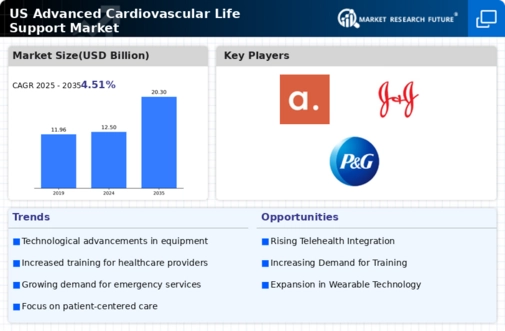Government Initiatives and Funding
Government initiatives aimed at improving healthcare infrastructure and emergency response systems are significantly influencing the advanced cardiovascular-life-support market. Federal and state programs are increasingly allocating funds to enhance emergency medical services (EMS) and support the acquisition of advanced life-support equipment. For instance, the US Department of Health and Human Services has introduced various grants to bolster emergency care capabilities. These initiatives not only facilitate the procurement of state-of-the-art devices but also promote training for healthcare professionals. As a result, the advanced cardiovascular-life-support market is likely to benefit from increased investments in technology and training, ultimately leading to improved patient care and survival rates.
Technological Innovations in Medical Devices
Technological innovations in medical devices are transforming the advanced cardiovascular-life-support market. The introduction of cutting-edge technologies, such as automated external defibrillators (AEDs) and advanced monitoring systems, is enhancing the effectiveness of emergency care. These innovations not only improve patient outcomes but also streamline the workflow for healthcare providers. The market is witnessing a shift towards more integrated and user-friendly devices that facilitate rapid response in critical situations. As healthcare facilities increasingly adopt these advanced technologies, the demand for sophisticated life-support systems is expected to rise. This trend indicates a promising future for the advanced cardiovascular-life-support market as it adapts to the evolving needs of emergency care.
Rising Awareness of Emergency Medical Services
There is a growing awareness among the public regarding the importance of emergency medical services (EMS) in saving lives, particularly in cases of cardiac arrest. This heightened awareness is driving demand for advanced cardiovascular-life-support systems, as individuals and communities recognize the critical role these technologies play in emergency situations. Educational campaigns and community training programs are increasingly emphasizing the need for rapid response and effective life-support measures. Consequently, the advanced cardiovascular-life-support market is experiencing growth as more organizations and healthcare facilities seek to equip their EMS teams with the latest technologies. This trend is expected to continue, further solidifying the market's position in the healthcare landscape.
Increasing Prevalence of Cardiovascular Diseases
The rising incidence of cardiovascular diseases in the US is a primary driver for the advanced cardiovascular-life-support market. According to the CDC, heart disease remains the leading cause of death, accounting for approximately 697,000 fatalities annually. This alarming statistic underscores the urgent need for effective cardiovascular interventions. As the population ages and lifestyle-related health issues become more prevalent, the demand for advanced life-support systems is expected to surge. Healthcare providers are increasingly investing in advanced technologies to enhance patient outcomes, which is likely to propel market growth. Thus, the advanced cardiovascular-life-support market is positioned to expand significantly as healthcare systems adapt to meet the growing needs of patients with cardiovascular conditions.
Aging Population and Increased Healthcare Expenditure
The aging population in the US is a significant driver of the advanced cardiovascular-life-support market. As individuals age, the risk of developing cardiovascular diseases escalates, leading to a higher demand for advanced life-support solutions. Additionally, increased healthcare expenditure by both public and private sectors is facilitating the acquisition of advanced medical technologies. According to the National Health Expenditure Accounts, healthcare spending in the US is projected to reach $6 trillion by 2027. This financial commitment is likely to support the growth of the advanced cardiovascular-life-support market, as healthcare providers invest in state-of-the-art equipment to address the needs of an aging population. The interplay between demographic trends and healthcare investment suggests a robust market outlook.














Leave a Comment